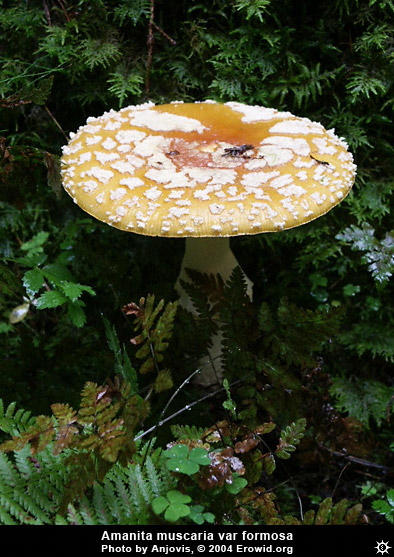(Amanita muscaria var. formosa)
 DESCRIPTION:
DESCRIPTION:A. muscaria var. formosa is the yellow-orange Fly Agaric mushroom. Its Cap is 5-15 cm (2-6") in diameter, convex to flat, and is yellow, deep orange, or red-orange. Its yellowish-buff to tan universal veil will entirely cover the youngest mushrooms, form pinkish-buff spots or warts on mature mushrooms, and may eventually wash or wear off with age. These spots often form concentric circles, although they may also appear random.
The Stalk is 5-15 cm (2-6"), has a ring and a bulbous base with rows of cottony patches. It is 1-3 cm (1/4 - 1 1/4") in diameter at the base, narrowing slightly towards the cap. The stalk is white, buff, or pale yellow-orange; fibrous, cottony, or scaly.
The Universal Veil which causes the buff spots on the cap also often forms concentric circles (usually 2-4) on the lower stalk at the top of the bulb.
Gills are free or nearly attached, crowded, broad to narrow, whitish.
Spore Print is white. Spores are 9-13 x 6.5-8 microns, broadly elliptical, smooth, colorless, and nonamyloid.
HABITAT:
On the ground, under pine, spruce, eastern hemlock, birch, poplar and oak. Often found in fairy rings.
RANGE:
Dominant A. muscaria in eastern North America. Common in the Sierra Nevadas but rare in the western Coastal ranges.
SEASON:
Late June - Novermber in the Northeast US; November - February in California.
COMMENTS:
Named the Fly Agaric because of it's use, when mixed with milk, as a method of killing houseflies.
Agaricals of the Hawaiian Islands : A. muscaria var. formosa


